AI, GPUs, and TVs: A Diary From CES 2025 Day 1
Maybe CES has hit rock bottom, after all
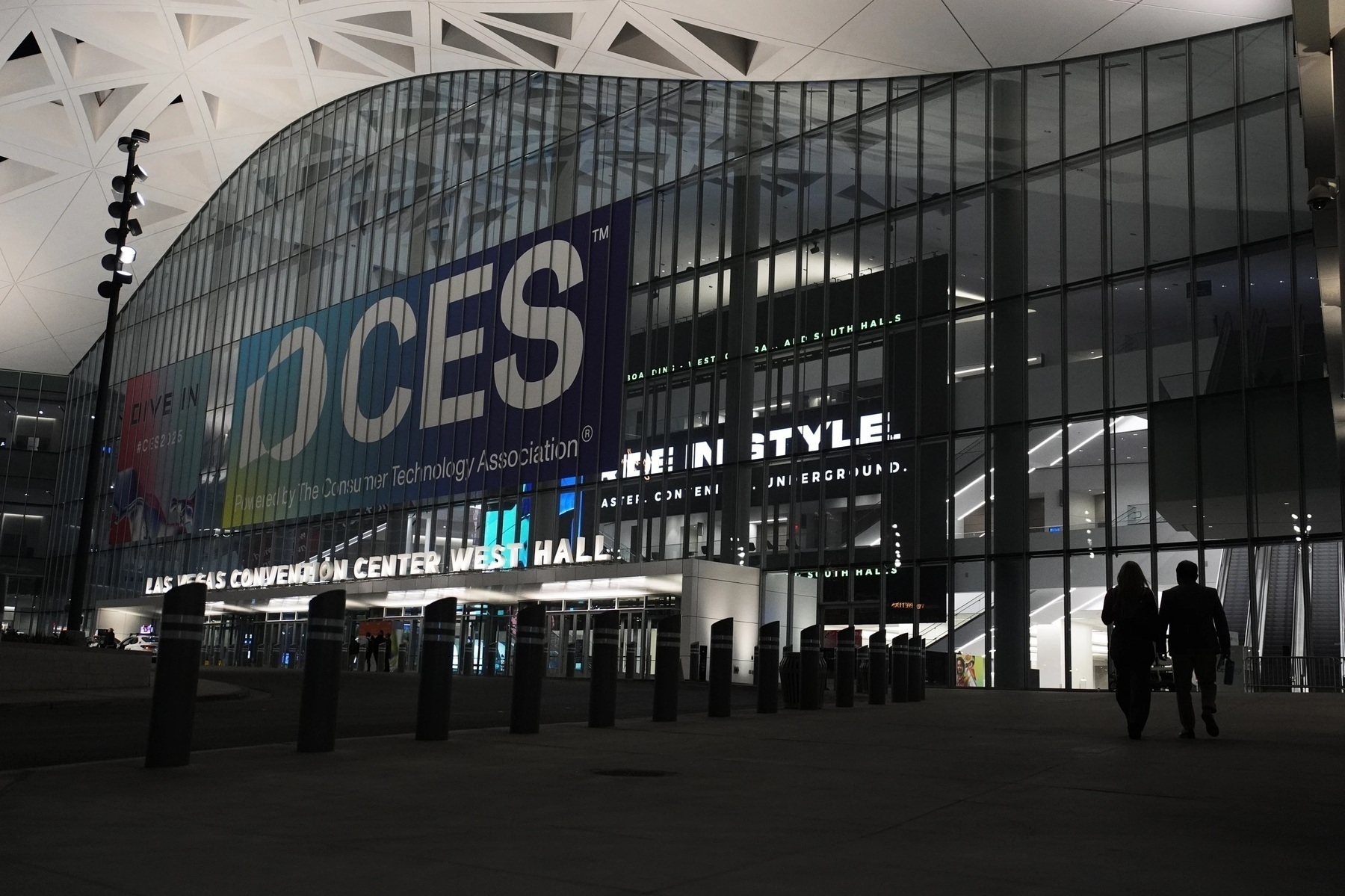 CES 2025 began Monday in Las Vegas. Image: The Associated Press.
CES 2025 began Monday in Las Vegas. Image: The Associated Press.
On the first day of the Consumer Electronics Show in Las Vegas, I completed my usual routine: I tuned into the big-name press conferences, took notes, caught up on social media reactions, and repeated until the news ran out and the sun set over the valley. CES hasn’t been about consumer technology as much as it has been about vibes, thoughts, and marketing for a while, but that is the inherent appeal of the show as it stands. In a fragmented, messy media environment, it is hard to get a gist of what the people who make the technology think sticks.
People often correlate marketing with greed: that companies only market products that are the best for them, not us. That is a true but incomplete assertion because marketing executives are of low intelligence. Spending an enormous amount to advertise congestive heart failure doesn’t make it any the more appealing because people generally do not want their heart to fail. That might be a humorous and irrelevant example, but marketing executives and consumers aren’t stupid. The colloquial expression, “You can’t polish a turd,” expresses this succinctly. If something is being marketed heavily, it is almost certain that it is viewed positively amongst the target audience.
CES isn’t about heart failure or marketing strategies; it is about generative artificial intelligence for the second year in a row. The AI boom hasn’t died, and I don’t think it ever will because it’s popular amongst the marketing crowd. It is OK to quibble about the popularity of generative AI — in fact, it’s healthy. But you can’t polish a turd. Money doesn’t grow on trees — if generative AI never stuck, technology’s biggest week wouldn’t be enveloped by it in the way it has been. “Big Tech” firms know better than to waste a free week in front of the media.
As I began looking over my notes, I tried to search for a theme so I could build a lede with it. But it quickly struck me that if a $3,000 supercomputer by a processor company was the most intriguing product I saw at the world’s largest technology trade show, perhaps CES has lost its fastball. These days, CES is emotionally cumbersome to cover because of just how much it has dwindled in recent history. There is an adage in the tech journalism sphere that nothing at CES is real and that it’s all a marketing mirage for the media. But now, the problem is that CES is almost too genuine to the point where a trade show that once was known for surprise and delight turned into a sea of monotony.
Last year, at CES 2024, generative AI was relatively new, and that made it genuinely exciting. It’s correct to contradict the rosiness with a brief reminder that the number of times “AI” was uttered during each keynote was nauseating, but it isn’t like this year was any different. Silicon isn’t exciting anymore, and all the industry decided to offer for 2025 was silicon. Intel, Advanced Micro Devices, Nvidia — they’re all the same, ultimately. I bet any “analyst” reading that last sentence is now suffering from an aneurysm because it’s a gross oversimplification of the entire silicon industry, but it’s true. Silicon suffers from the same stagnation smartphones did four years ago. New neural processing cores and ray tracing have never been the bread and butter of CES.
Similarly, every smart home product felt like beating a dead horse. Matter promised to be a smart home standard that made most accessories platform-agnostic, meaning they could be used with Google Home, Apple’s HomeKit, and Amazon’s Alexa all at once. (It’s not to be confused with Thread, which is a mesh networking connectivity protocol, not a standard.) But with the influx of Matter products in recent history, it isn’t the lack of adoption that bothers me, but reliability. The platform agnosticism was only rolled out about a year ago and still is unreliable, with Jennifer Pattison Tuohy, a smart home reporter for The Verge, calling it “completely broken” in late 2023. Since then, Matter has improved, but variably.
And CES, for better or worse, always seems to have the most televisions than any trade show by far — reliably. But this year, the main attraction wasn’t new display panels or considerable improvements to picture quality, but Microsoft Copilot in LG and Samsung TVs. Again, it’s hard not to believe the industry is headed in the wrong direction. CES in its prime existed to showcase the gadgets nobody would ever buy — think rollable phones and see-through televisions. But the politics of making maximum profit per dollar spent on constructing fancy exhibitions seems to have watered down the spontaneity that once brought reporters to CES. Marketing executives aren’t stupid, but as the day went by, I kept wishing they were.
Still, I worked through the pain and my misgivings about the show to compile a list of some of my favorite finds from the first day of what I feel will become a grueling three days of press conferences going over incremental product updates. The resulting chronicle is one of incremental updates, somewhat surprising numbers, and a story of marketing and consumerism hiding between the lines.
Intel
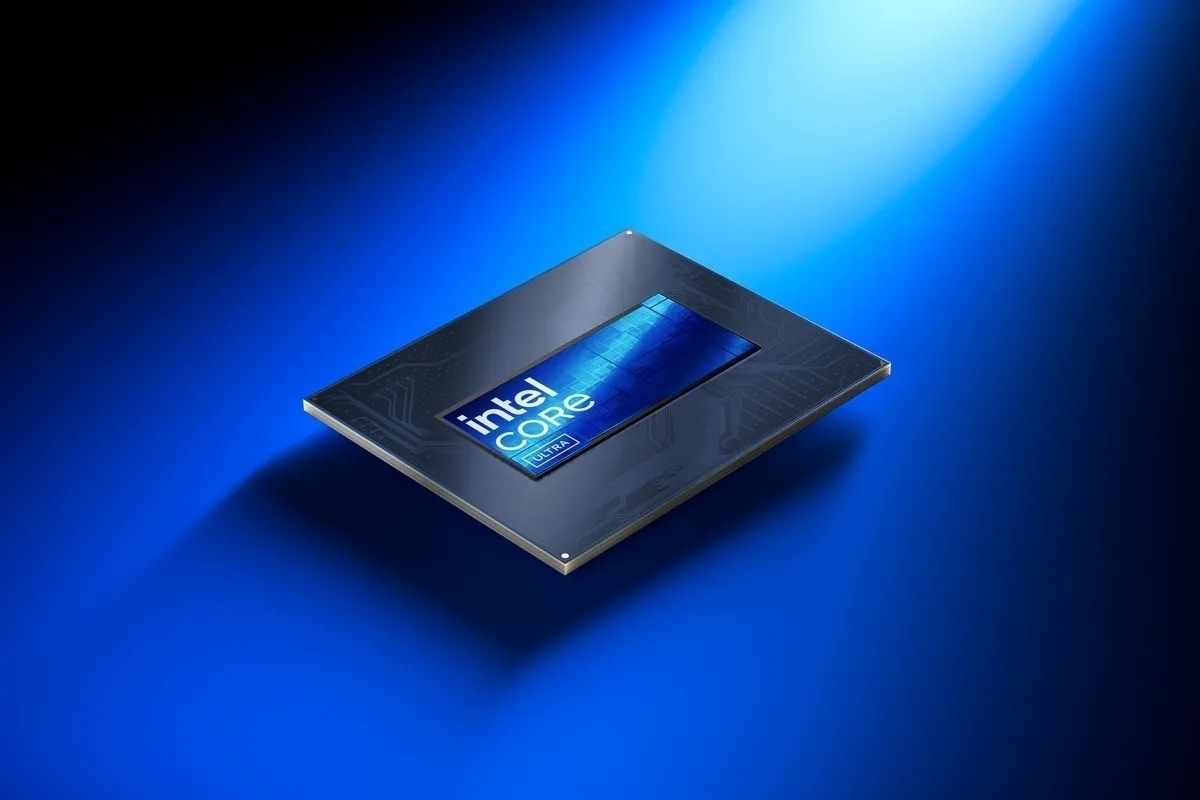 Image: Intel.
Image: Intel.
Anyone with even a slight modicum of knowledge about the current state of the silicon industry knows Intel is in hot water. It spun off its foundry business due to dwindling profits, abruptly fired its technically minded chief executive over those dwindling profits, and has been consistently behind in every market for years. Its chief competitor, Advanced Micro Devices, is running laps around it in nearly every important benchmark; Nvidia makes its graphics processing units look like toys; and it lost its most important business partner, Apple, four years ago. Intel, by any objective measurement, is doing awfully, both morale-wise and economically. After its CES 2025 announcements — and the subsequent ones from AMD and Nvidia — its stock price fell to its lowest since the firing of Pat Gelsinger, its prior chief executive.
Yet, the company is still making moves, though perhaps in the wrong direction. On Monday, it announced a line of processors called Arrow Lake, meant to be the successor to its Raptor Lake series, announced at CES last year. The Arrow Lake processors Intel announced Monday are meant for gaming laptops from the likes of Asus, not Copilot+ productivity-oriented PCs. (Lunar Lake, Intel’s bespoke AI chip, will still be used in the latter category for the foreseeable future.)
Intel claims Arrow Lake’s gaming variants offer 5 percent better single-threaded performance and 20 percent improved multithreaded over its Raptor Lake processors from last CES, and Arrow Lake models will ship with Nvidia’s 50-series graphics cards, adding to the performance increases. Other, non-gaming-focused laptops will use the H-model processors, and Intel claims their single-threaded performance will be up to 15 percent better. Other variants, like the U-series for ultra-low power consumption, were also announced.
The 200HX series, used in gaming laptops, won’t ship in products until late in the first quarter of the year, the company says, while the 200H and 200U chips have already begun production and will be in laptops in just a few weeks.
I say Intel’s announcements are heading in the wrong direction because they don’t follow the pattern of every other hardware maker at CES. If anything, Intel should’ve one-upped its announcements by announcing a successor to Lunar Lake, its AI chip line, to compete with AMD and Nvidia, who juiced their announcements chock-full of AI hype just mere hours after Intel’s keynote address. That isn’t to say Intel’s presentation was entirely full of duds; the company also announced Panther Lake, its series of 1.8-nanometer processors using its 18A process, is shipping in the second half of 2025. But when Intel is reassuring analysts it’s not leaving the discrete GPU market and advertising a 4 percent increase in the PC market year-over-year, it’s hard to have any confidence in the company. Intel is directionless, and that became even more apparent at CES.
AMD and Dell
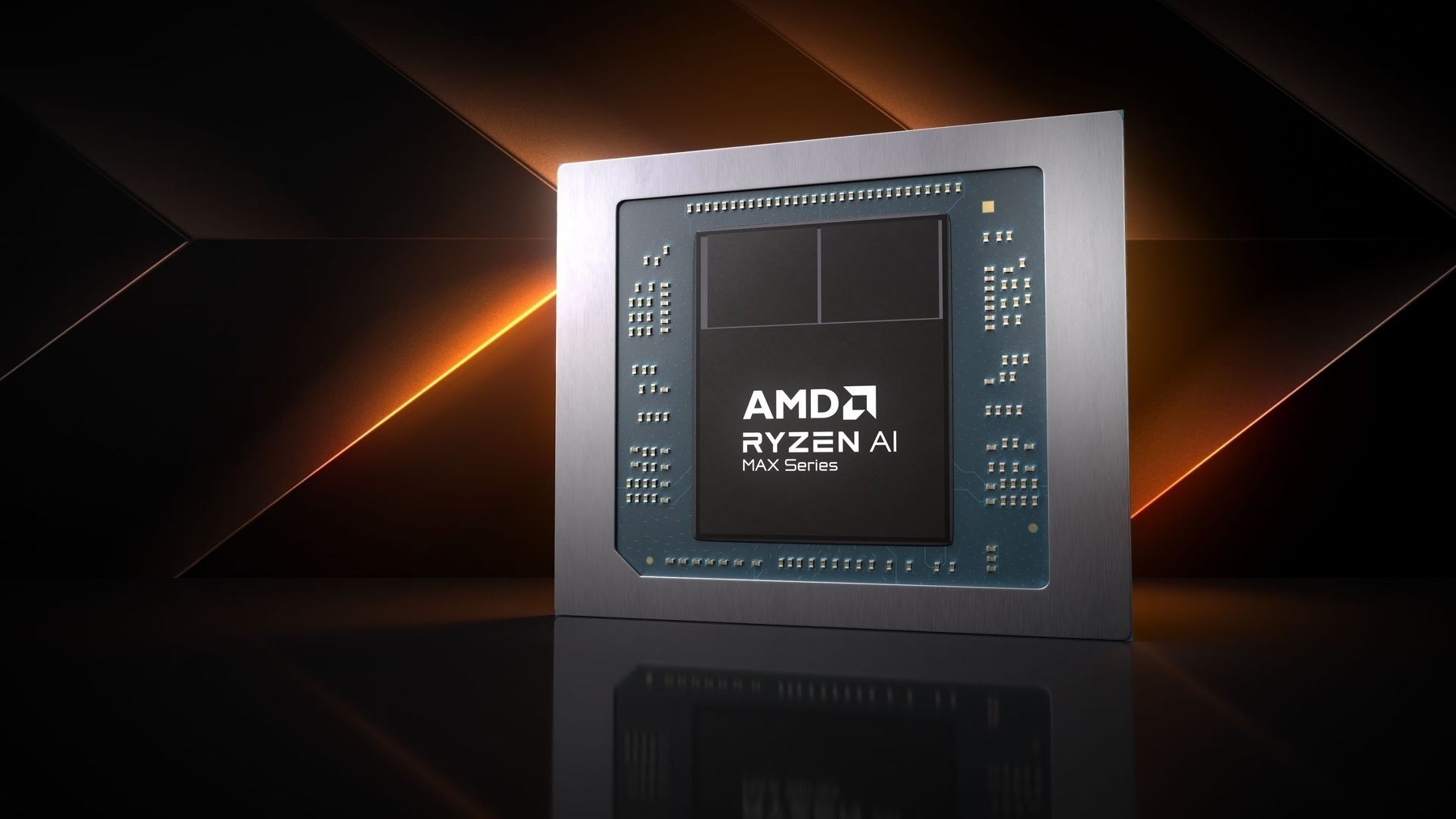 Image: AMD.
Image: AMD.
AMD’s keynote, similar to Intel’s, was off. For one, it didn’t bring out Dr. Lisa Su, its charismatic chief executive, to deliver the address. And it didn’t announce Radeon DNA 4, its next-generation GPU platform that powers the Radeon RX 9070, its latest GPU, onstage either, leaving it for a press release. Detractors online believe this is due to Nvidia’s announcements, while others think the lack of interesting announcements was due to Dr. Su’s absence. Instead, the CES presentation focused on its latest flagship processor, mobile chips, and new partnership with Dell.
The company announced the 9950X3D, its highest-end processor with 16 cores on the Zen 5 architecture, its latest. AMD claims it’s “the world’s best processor for gamers and creators,” with an 8 percent performance boost in games over the last-generation 7950X3D and a 15 percent increase in content creation tasks, such as video editing. But perhaps the most ambitious claim is that the processor is 10 percent faster than Intel’s latest, the Core Ultra 285K. These claims are yet to be tested, as the processor — along with its lower-end counterpart, the 12-core 9900X3D — will be available in March, but they seem respectable at first glance.
AMD spent most of its time, however, announcing its new lineup of mobile processors, called the Ryzen AI Max series. Both the Ryzen AI Max and AI Max Plus have AMD’s most powerful graphics, with up to 15 CPU cores — just like the 9950X3D, but in mobile form — 40 RDNA 3.5 compute units, and 256 gigabytes-a-second memory bandwidth. Together, AMD says the AI Max Plus beats Apple’s mid-range M4 Pro processor, announced late last year, yet probably with worse heat management and power consumption. Both Ryzen AI Max chips consume up to 120 watts of power at their peak, but AMD isn’t giving any details on thermal performance, as it most likely varies drastically between laptop models. The processors are Copilot+ PC-compliant and begin shipping in the first quarter of 2025, with the first computers being from Asus and a new HP Copilot+ mini PC, similar to Apple’s Mac mini.
Perhaps AMD’s strangest announcement at its press conference was its new partnership with Dell, a company that historically has always shipped Intel and Nvidia processors in its ever-popular laptops. To accompany the news, Dell announced it would overhaul its naming structure, ditching the XPS, Latitude, and Inspiron for three new variants: Dell, Dell Pro, and Dell Pro Max. The names are a one-to-one rip-off of Apple’s iPhone naming scheme, but it didn’t stop there — in addition to the three variants, each one has three specifications: Base, Premium, and Plus. This results in some extraordinary product names, like Dell Pro Max Plus, Dell Premium, and Dell Pro Base.
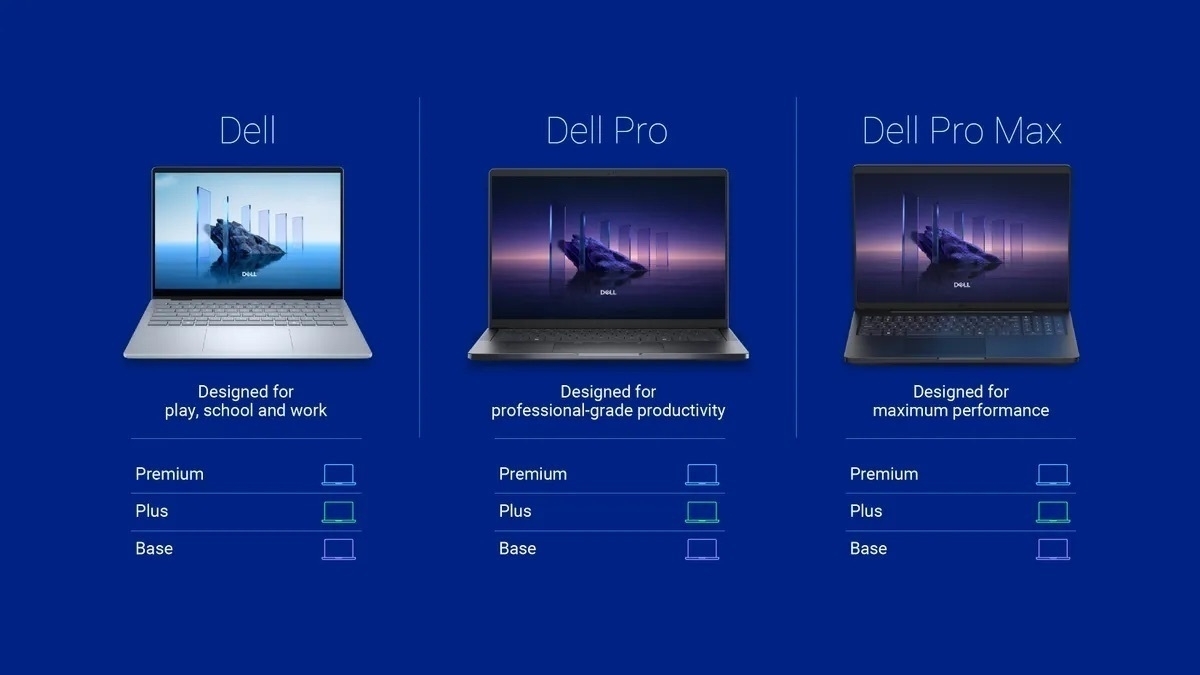 Image: Dell.
Image: Dell.
The internet has been ablaze with comedy for the past day, but seriously, these names are atrocious. Not only could Dell’s product marketing team not ideate a new branding strategy, but it chose to copy Apple’s worst naming scheme and then make it worse. Proponents of the new names say they make more sense than “Dell XPS,” where XPS originally stood for “Extreme Performance System,” but the new names just don’t logically connect. Dell Pro Base is a better product than Dell Premium, for instance. It’s a completely unintuitive, embarrassing system, destroying decades of brand familiarity with one misstep. Truth be told, it embodies the fundamental problem with CES.
Qualcomm
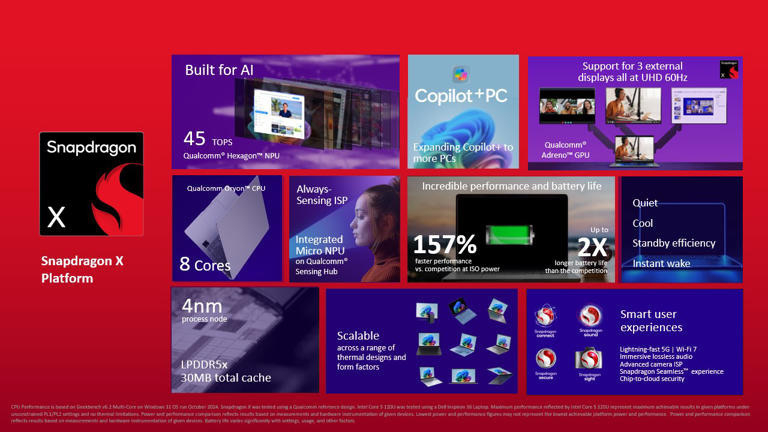 Image: Qualcomm.
Image: Qualcomm.
Qualcomm, Intel’s biggest foe, launched a new Copilot+-capable processor meant to power cheaper so-called “AI PCs” below $600. The processor, called Snapdragon X, has eight cores and a neural processing unit that performs 45 trillion operations per second, or TOPS. The processor joins the rest of Snapdragon’s Arm-based computer processor lineup; it’s now composed of the Snapdragon X, Snapdragon X Plus, and Snapdragon X Elite. The company says the processor will begin shipping in various devices from HP, Lenovo, Acer, Asus, and Dell in the first half of 2025.
The Snapdragon X will make Copilot+ PCs their cheapest yet, though Windows on Arm is still shaky, with many popular apps broken entirely or running in Compatibility Mode. Still, however, the chip will shake up the budget laptop business, putting Intel and AMD on their toes to develop cheaper Copilot+-capable processors. Currently, the only chips based on the x86 instruction set — the one used by Intel and AMD — are cost-prohibitive and flagship, which isn’t ideal for schools or corporate buyers.
The processor is built on Taiwan Semiconductor Manufacturing Company’s 4-nm process node, bringing “two times longer battery life than the competition,” according to Qualcomm. I haven’t seen any laptops at CES with the Snapdragon X chip yet, but I assume they’re coming in the next few months.
Samsung
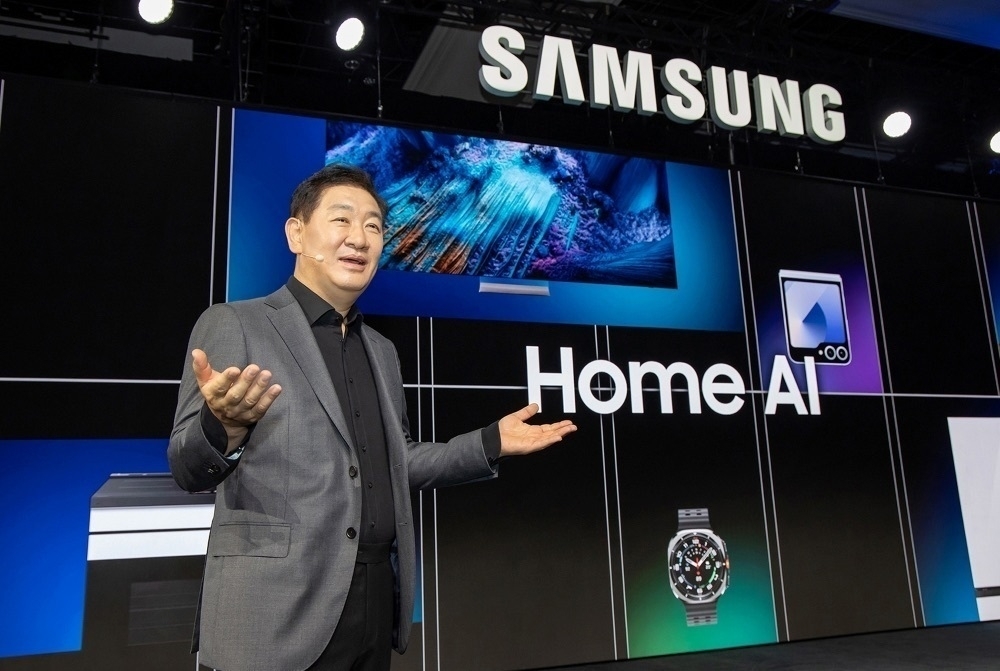 Image: Samsung.
Image: Samsung.
Samsung on Monday re-announced much of what it said last year at CES: AI, AI, AI. The company is bullish on AI in the smart home, emphasizing local AI processing and connectivity between various Samsung products, including SmartThings — its smart home specification — and Galaxy devices. The story is much of the same as last year, but the difference lies in semantics: While last year’s craze was about the technology itself and generative experiences, Samsung this time seems more focused on customer satisfaction, much like Apple. Whether that vision will pan out into reality is to be determined, but it sounds appropriate for the AI skepticism climate the world appears to live in currently.
Samsung calls the initiative “Home AI” — because, of course, everything deserves a brand name — and it evoked a half-futuristic, half-dystopian future of the smart home. For one, Samsung didn’t mention Matter in the AI portion of its presentation. It did eventually, in a separate, more smart home-oriented section of the keynote, but the omission seems to allude to the fact that Matter is flaky and unprepared for generative AI. Many of the things Samsung wants to do require a deep tie-in between hardware and software. For example, one presenter gave a scenario where a Galaxy Watch sensed a person couldn’t fall asleep and automatically set the thermostat to a lower temperature. That’s more than just the smart home: it’s a services tie-in. Dystopian, yet also eerily futuristic.
Samsung also emphasized personalization in its vibes-heavy and announcement-scant conference but put the ideas in terms of AI because CES is a creative writing exercise for the world’s tech marketing professionals. (See the beginning of this article.) Voice recognition and user interface personalization stood out as key objectives of the Home AI initiative — a presenter showcased an instance where a user, with high-contrast mode enabled on their smartphone, spoke to their dryer, which recognized their voice and automatically activated its own high-contrast accessibility settings. Whether that fits the new-age definition of “AI” is debatable, but it’s a perfect example of the Home AI initiative.
In a similar vein, Samsung finally announced a release date for its Ballie AI robot, which for years has promised a personalized AI future in the form of an adorable spherical floor robot with a built-in projector and speakers. Ballie was first demonstrated five years ago at CES 2020, but Samsung updated it at 2023’s show before even releasing the first generation. Now, Ballie is powered by generative AI — because of course it is — but retains much of the same feature set. Think of it as a friendlier, smaller version of Amazon’s Astro, a 2021-era robot that ran Alexa and cost an eye-watering $1,600. Ballie, like Astro, has a camera for home security but runs on SmartThings, allowing users to toggle other parts of their smart home via the robot. Ballie is shipping in the first half of the year, according to Samsung, but the company provided no concrete release date, price, or specifications.
Samsung also announced the successor to the company’s popular The Frame television: The Frame Pro. The Frame, for years, has been regarded as one of the most aesthetically pleasing televisions, not in terms of picture quality, but when it is turned off. The Frame can cycle through art and images and comes in a variety of finishes to complement a space, almost as if it’s an art installation rather than a TV. But The Frame has been plagued by software features, has mediocre image fidelity — it only has a quantum dot LED whereas most other TVs in its price range have organic-LED displays — and doesn’t get as bright as other LED TVs Samsung sells because of the anti-reflective coating, which helps display art more naturally.
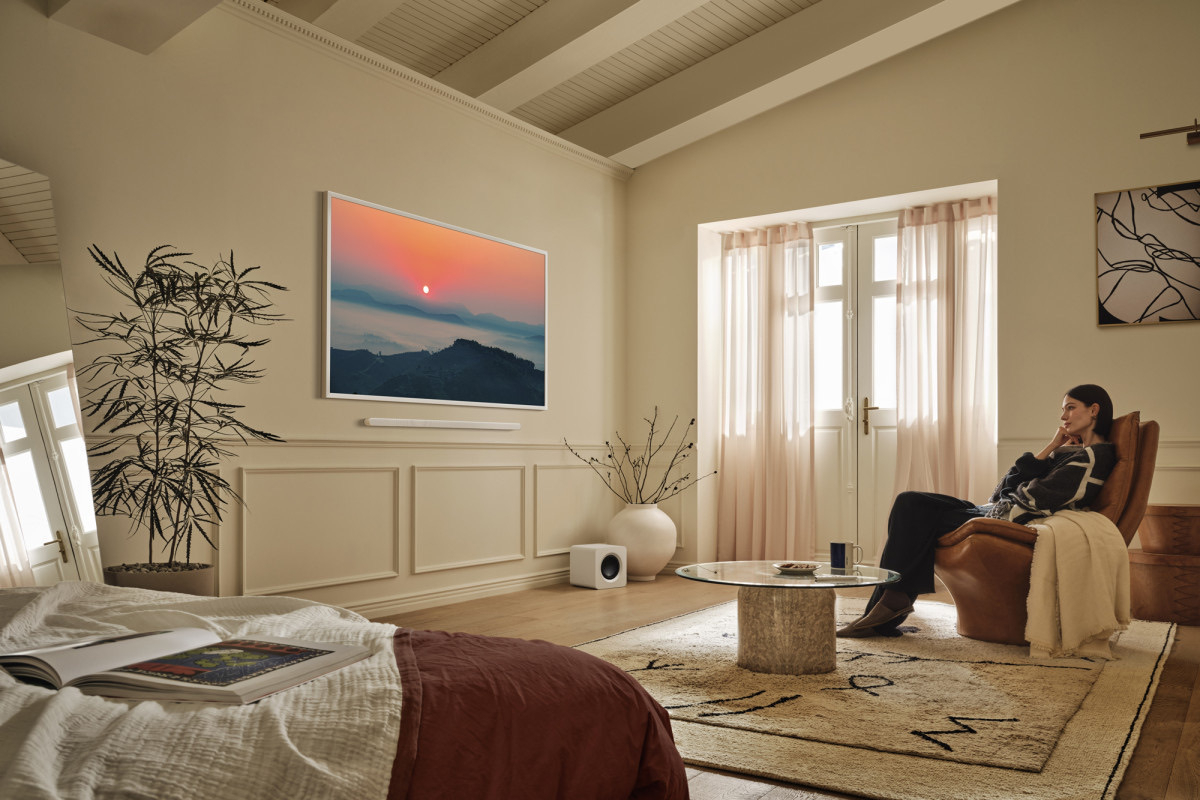 The Frame Pro. Image: Samsung.
The Frame Pro. Image: Samsung.
The Frame Pro, by contrast, aims to address some of these issues. It now features a nerfed mini-LED display, which provides a boost in contrast and brightness since it splits the display panel into multiple local dimming zones. This way, only one part of the television can receive light while the other parts are completely off. The catch is that The Frame Pro’s display isn’t a true mini-LED panel, where the zones are spread throughout the display. (Every MacBook Pro post-2021 has a mini-LED display; to test it, go to a dark room, open a dark background with a white dot in the center of the screen, and observe the visible blooming behind that dot. That’s mini-LED’s dimming zones in action.) Instead, The Frame Pro has these dimming zones at the bottom of the screen, controlling the brightness vertically instead of in a grid pattern across the display.
I am sure this will provide some tangible difference knowing how bad the picture quality of the original Frame is in comparison to other high-end televisions, but I don’t think it will fully alleviate the pain of the matte display, which causes considerable color distortion and results in a washed-out picture. The Frame Pro also has a 144-hertz refresh rate, but because of Samsung’s abominable stubbornness to support Dolby Vision, it only has HDR10+, Samsung’s proprietary high dynamic range standard. Modern set-top boxes like the Apple TV support it, but content is scarce and not nearly as well-mastered as Dolby Vision. Really, The Frame Pro is still a compromise, and without a price, I’m unsure if the new features make it a better value over the equally compromised Frame.
Samsung’s announcements, while repetitive, were a good breath of fresh air after a packed morning full of processor updates. But none of its new products, unlike some other CES presenters’, has release dates, prices, or even concrete feature concepts. The entire address was one large, lofty, vibes-based presentation. I guess that fits the CES theme.
LG and Microsoft Copilot
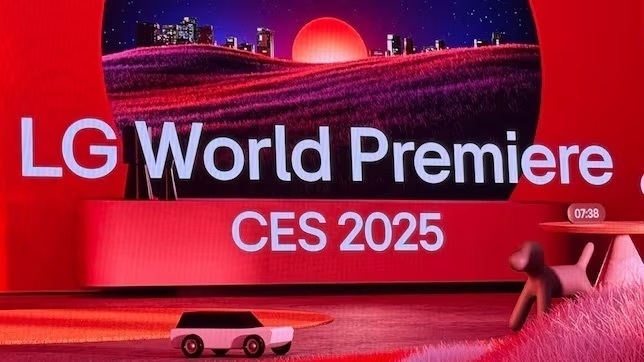 Image: LG.
Image: LG.
LG began its announcements on Sunday, launching its 2025 television lineup infused with AI. But unlike tradition would call it, the AI wasn’t image-focused. There were modest improvements to AI Picture Pro and AI Sound Pro, but for the most part, it centered around Microsoft Copilot coming to webOS, with LG even going as far as to reprogram the microphone button to launch the AI assistant. A chatbot is built into the operating system, too, and the remote is now dubbed the “AI Remote.” (It’s worth noting Samsung is also adding Copilot to its TVs as well, though much less conspicuously.)
LG hasn’t detailed the Copilot integration yet, without even going as far as to add a screenshot to its press release — all the company has said is that the functionality is coming to the latest version of webOS with the new line of TVs, but with no release date. It’s unclear what Microsoft’s OpenAI-powered chatbot would do, but LG’s own bot would take the lead for most queries, with Copilot being used to look up additional information, says the company. Again, I’m unsure and skeptical about what “information” refers to, but that’s par for the course at CES.
It all circles back around to my lede, nearly 3,500 words ago: CES is an elaborate marketing exercise; sometimes, it delivers hits and otherwise duds. But there’s clearly some kind of pent-up demand for such a product, so much that both Samsung and LG partnered with Microsoft — which hasn’t created anything remotely close to television software in its entire corporate history — to integrate an AI chatbot within webOS and Tizen. It really is unclear what that pent-up demand entails, but what makes this year’s CES so odd is that the companies presenting this year don’t seem to be eager to showcase their latest technology freely. Intel, AMD, and Samsung have all disappointed with their announcements this year.
Either way, color me hesitant to welcome Copilot on my TV anytime soon.
TCL
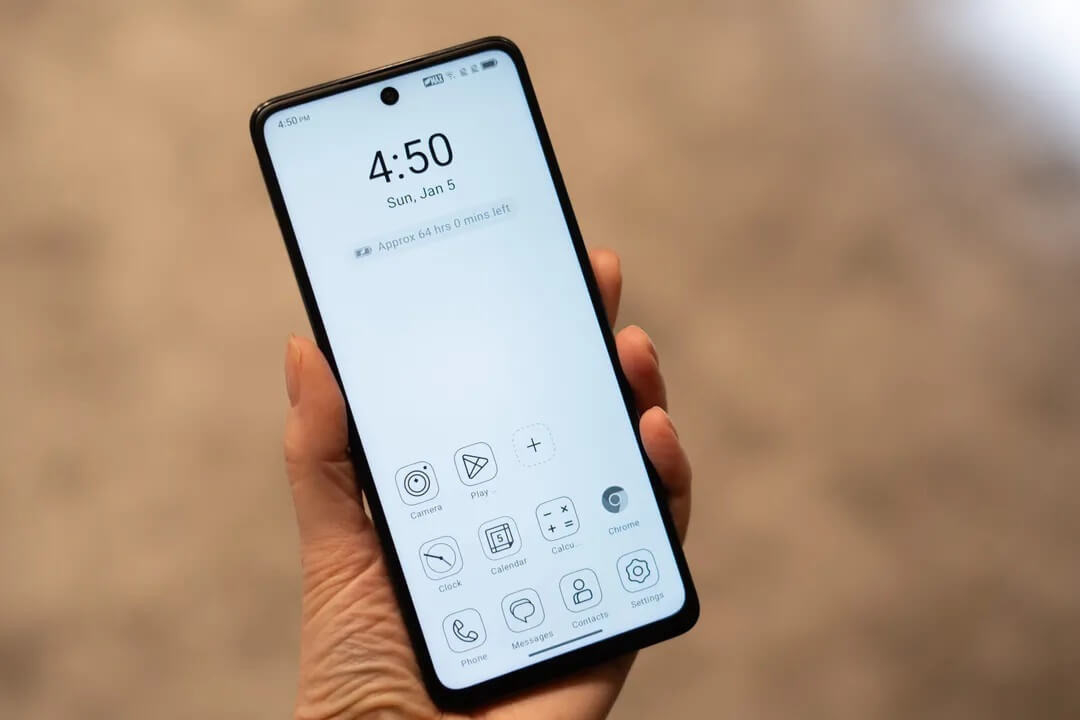 The TCL 60 XE. Image: Allison Johnson / The Verge.
The TCL 60 XE. Image: Allison Johnson / The Verge.
TCL kept its announcements to a minimum at CES this year, launching a new Android phone called the TCL 60 XE that can switch between a full-color and e-ink-like display with just the flick of a switch at the back of the device. The feature is called Max Ink Mode, and it uses TCL’s Nxtpaper display technology to toggle between the two modes. Nxtpaper isn’t an e-ink display, but it mimics the functionality of e-ink through a standard LCD. The LCD has a reflective layer that eliminates backlight glare and diffuses light, thereby faking the matte, dull e-ink look without rearranging pigment particles using electricity. Because Nxtpaper is just a special LCD, it still operates like a normal screen until the switch is flipped, which changes the appearance of Android.
The TCL 60 XE, otherwise, is a typical Android budget phone, with a 50-megapixel rear camera, 6.8-inch display, and “all-day battery life.” No other specifications were given, but the product is promised to begin shipping in Canada by May and in the United States later this year. (It is exclusive to North America.)
TCL also announced a new projector, called the Playcube, which is an adorable cube-shaped modular device. No other details were provided, however, probably because it is most likely just a concept. But the Nxtpaper 11 Plus, the company’s next-generation tablet, did get more specifications: it features an 11.5-inch display built on Nxtpaper 4.0 and a 120-hertz refresh rate. Nxtpaper 4.0, according to TCL, uses improved diffusion layers to offer better sharpness and brightness. However, no pricing information and release date were issued by TCL in its press release.
TCL is always a vendor I enjoy hearing from at CES, mostly because it doesn’t have the bandwidth to put on its own extravagant events. While typical for the company, the Max Ink Mode really was intriguing to look at. TCL, however, didn’t introduce its full TV line at CES this year, which is atypical for a company that always seems to offer the largest screens at some of the lowest prices. It did preview a mini-LED one, however, but provided no other specifications or pricing.
Matter and the Smart Home
CES typically brings a plethora of smart home devices, and in recent years, it has become a breeding ground for Matter and Thread appliances. But as I said earlier, Matter continues to be an unreliable standard for most important smart home accessories, with frequent bugs and connectivity issues plaguing the experience. Still, though, this CES has been high on hardware products and less focused on the Matter protocol itself, unlike the last few years. Here are some of the gadgets and announcements I found most intriguing.
Ecobee launched a cheaper smart thermostat to join its lineup of what I think are the best HomeKit-compatible thermostats, alongside the Matter-enabled second-generation Nest Learning Thermostat. The new one, which costs $130, has all the smart features of the premium models but lacks a few bells and whistles, such as the air quality sensor. It can be paired with Ecobee’s SmartSensors, sold separately, but doesn’t support Matter, which Ecobee promised to do in 2023. (It still supports Google Home, Amazon Alexa, HomeKit, and Samsung SmartThings, so take Matter’s omission with a grain of salt.) I think it’s the best smart thermostat for beginners just getting acquainted with a smart home.
HDMI 2.2 brings 4K resolution at 480-hertz with 96 gigabits per second of bandwidth. The new protocol, developed by the HDMI Forum and called Ultra96 HDMI, also includes a latency indication specification to allow connected devices to communicate with each other and compensate for lag. The HDMI Forum intends for it to mainly be used for audio receivers and says that it performs better than HDMI-CEC, which enables the same cross-device communication in the current HDMI 2.1 specification. HDMI 2.2 cables will begin shipping later this year.
Schlage, the renowned door lock maker, announced a new ultra-wideband-powered smart lock with a twist. While some smart locks use Bluetooth Low Energy and near-field communication to communicate — such as Schlage’s own Encode Plus lock, which works with Apple’s home key — Schlage’s latest, the Sense Pro, uses the ultra-wideband chip in certain smartphones to detect when a user is nearing their door lock and automatically unlock it for them. This is possible due to ultra-wideband precision; the technology is used in Apple’s Precision Finding feature, proving its reliability. I don’t think pulling out my phone and holding it against my door is very cumbersome, but this could potentially be useful when my hands are full. The company says the Sense Pro will be available in the spring.
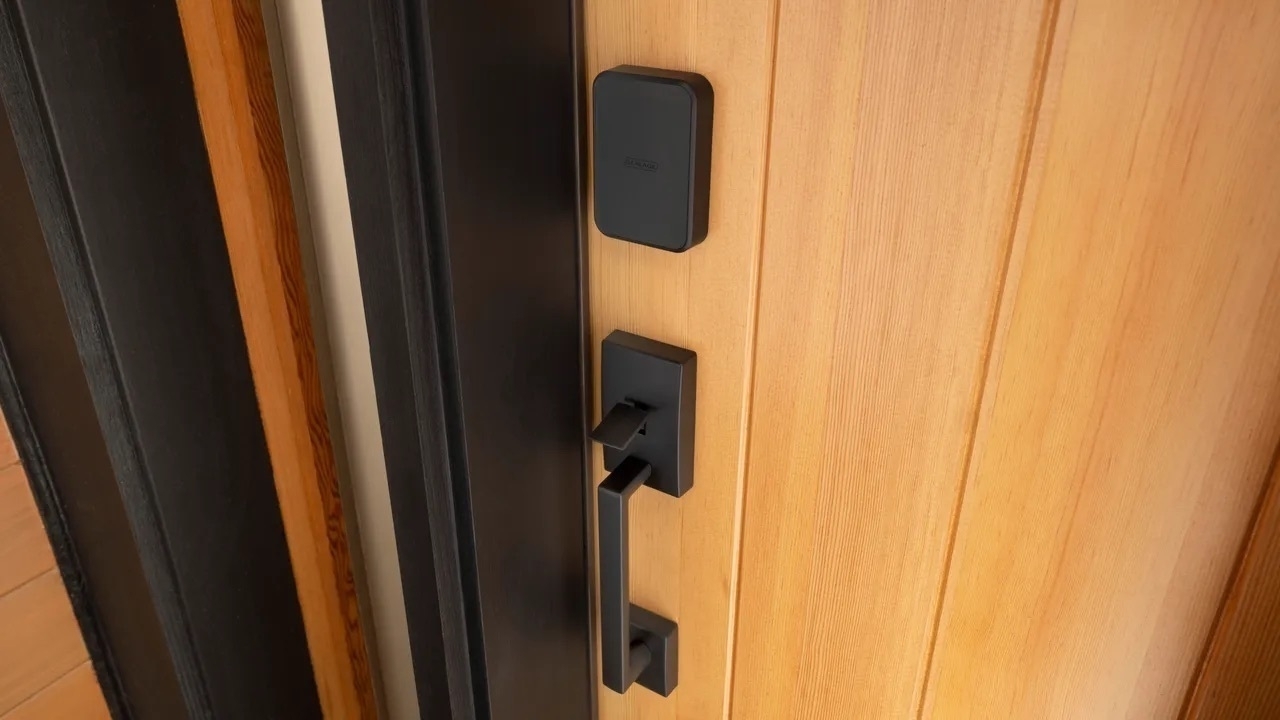 The Schlage Sense Pro. Image: Schlage.
The Schlage Sense Pro. Image: Schlage.
Aqara is launching a 7-inch wall-mounted tablet and home hub combo it calls the Panel Hub S1 in addition to the Touchscreen Dial V1 and Touchscreen Switch S100, three unintuitive names for products that aim to act as souped-up light switches. The devices can be installed in lieu of light switches to control smart home devices connected via a home’s local Thread and Matter networks. This is the promise of Matter: interoperability so that any device can tie into a smart home ecosystem without connecting to one of the big three platforms. Each device features a touchscreen, but the Panel Hub S1 has the largest. It reminds me of Apple’s rumored HomePod with a screen, except perhaps much cheaper. The Dial V1 has a scroll wheel to control devices, and the Touchscreen Switch occupies the space of one switch with a screen for more details. All three products are shipping in the first quarter of the year.
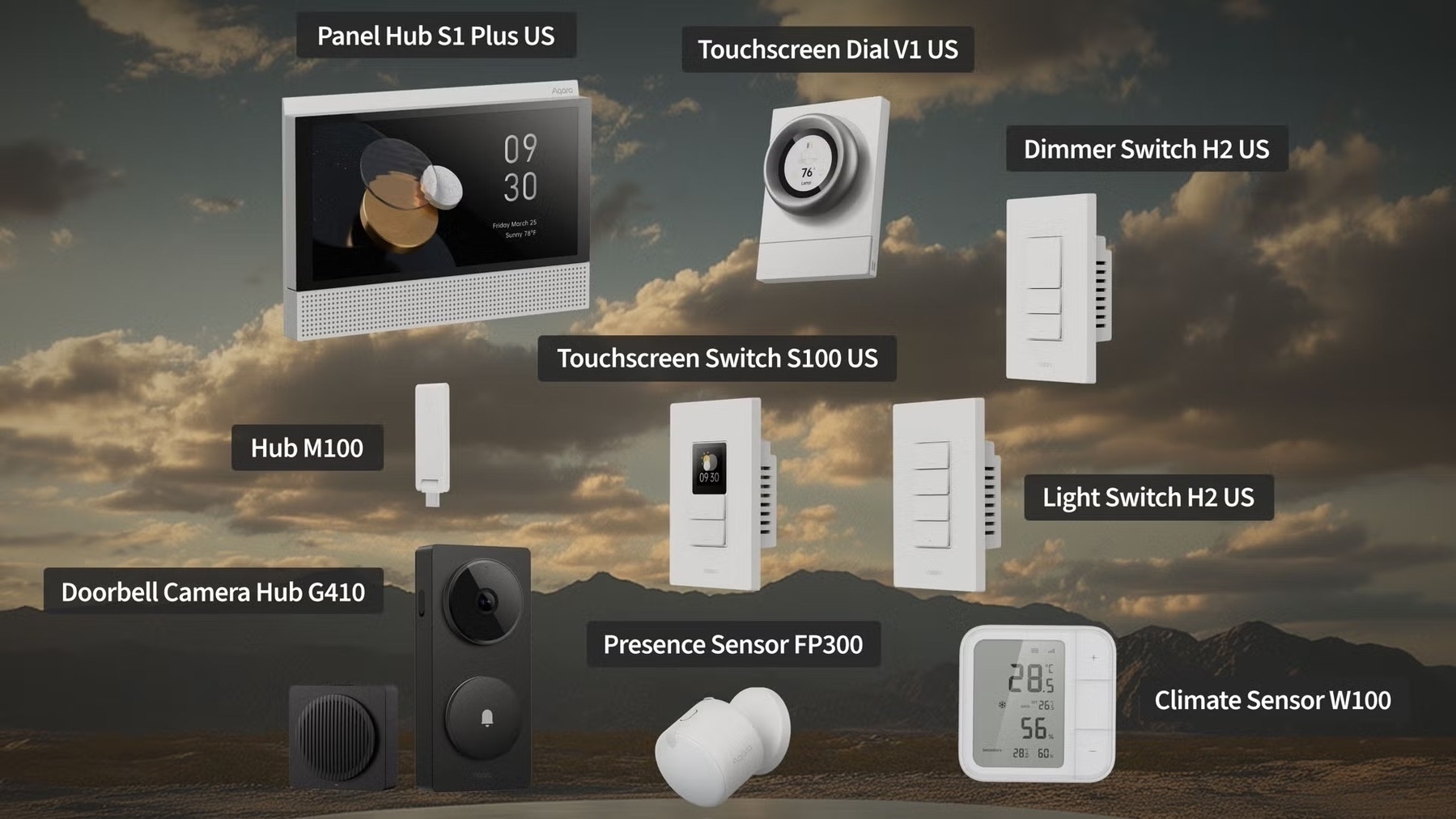 Image: Aqara.
Image: Aqara.
Google announced Gemini is coming to third-party TVs via Google TV, the company’s smart TV software that certain TV manufacturers like Hisense pre-install on their devices. Gemini previously was confined to the Google TV Streamer, Google’s latest set-top box that replaced the Chromecast to much chagrin last year, but now the company is bringing it to all Google TV-enabled televisions. I think this makes more sense than Copilot because Google TV in and of itself is a streaming platform with its own recommendation engine, so Gemini could answer questions about certain items or recommend what to watch.
The Star of the Show: Nvidia
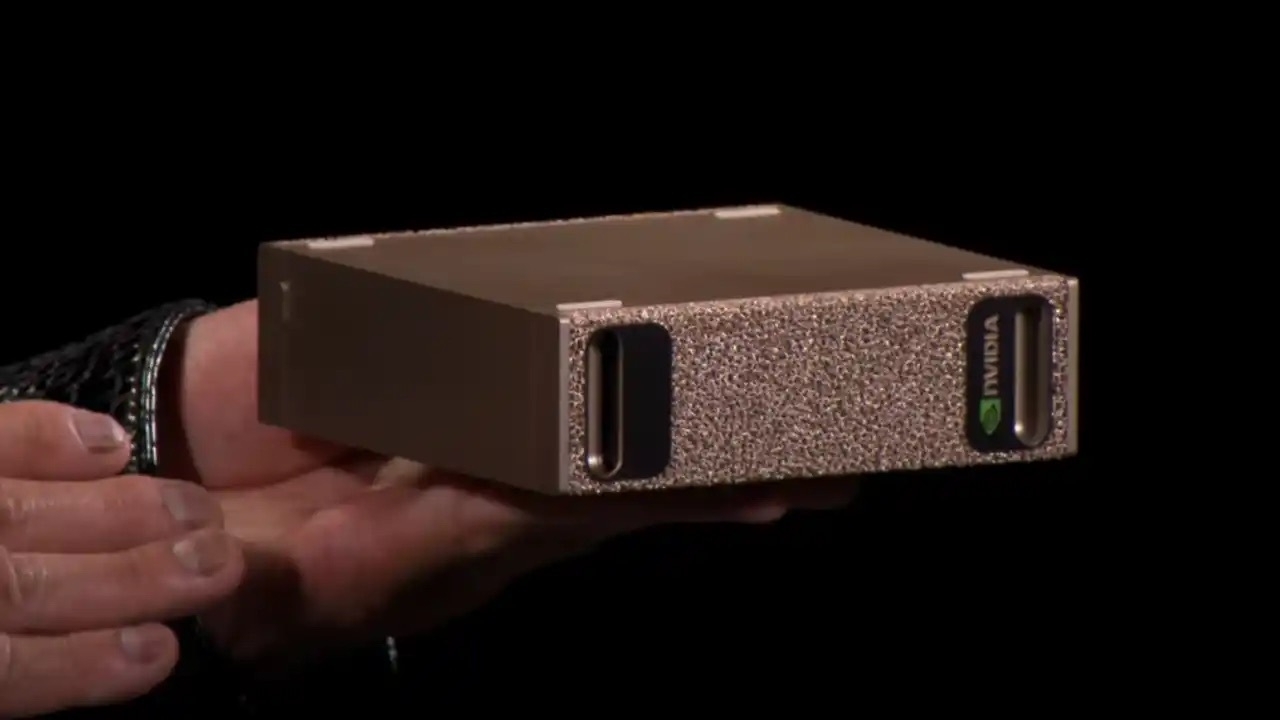 Nvidia’s Project Digits.
Nvidia’s Project Digits.
Nvidia’s Monday evening presentation was perhaps the most exciting, hotly anticipated event of the day. The keynote attracted attention like I have never seen in recent CES history, with nearly 100,000 people tuning in on the live stream and 14,000 attending in Las Vegas — 2,000 above the capacity limit of the arena. Nvidia, after the launch of ChatGPT and its subsequent competitors, quickly rose to become the most valuable technology company due to its GPUs used for AI training. At CES, the company announced its latest gaming GPU line, the RTX 50-series, as well as other AI-focused processors.
The RTX 50-series GPUs are powered by Nvidia’s Blackwell processor architecture. The new highest-end card, the RTX 5090, can perform up to 4,000 trillion operations per second, 380 ray tracking tera floating point operations per second (10 to the 12th power), and has a 1.8 terabytes-per-second memory bandwidth. The company claims the 5090 is two times faster than its predecessor, the RTX 4090, in gaming tasks thanks to so-called tensor cores — components of the card reserved for AI processing — and the next generation of Nvidia’s deep learning super sampling, or DLSS, AI-powered upscaling.
But perhaps the more awe-inspiring part of the keynote is when Jensen Huang, Nvidia’s chief executive, said the RTX 5070 — currently the lowest-end card in the lineup — matches the RTX 4090’s performance in most tasks. For context, the 4090 is currently the most performant graphics processor in the world and takes up an enormous amount of volume in a computer case, but if Nvidia is to be believed, the lowest-end, smallest card in its flagship lineup now matches its performance. That’s bananas.
Nvidia announced pricing for the new cards, too: $2,000 for the RTX 5090, $1,000 for the 5080, $750 for the 5070 Ti — a slightly upgraded version of the 5070 — and a mind-boggling $550 for the 5070. The highest-end 4090 from last year cost $1,500, meaning new buyers can save $1,000 and get an equally performant card. This feat has even made Huang claim that his company’s processors are defying Moore’s Law, a concept in computer science that states the number of transistors in a processor doubles every two years. I am unsure if such a bold claim is true, but either way, Nvidia’s latest processors are incredible, and Huang mentioned many times during the keynote that it wouldn’t be possible without AI, which now does all the heavy lifting in upscaling.
The company also announced a plethora of large language and video models designed to generate synthetic training data for new, smaller models. The language models are based on Meta’s Llama 3.1 and are called the “Llama Nemoneutron Language Foundation Models,” and they are fine-tuned for enterprise use and generating training data. Nvidia calls the video model Cosmos, and it says it is the first AI model that “understands the real world,” including textures, light, gravity, and object permanence. (Nvidia Cosmos was trained on 20 million hours of video to achieve this, but I wonder where the video came from.) Both models aim to help Nvidia achieve infinite AI scaling by feeding smaller models data generated by the advanced ones. For instance, Huang said Nvidia Cosmos could simulate “millions of hours on the road” with “just a few thousand miles” to feed a self-driving computer because not every simulation can be created in the real world.
This composed the overarching theme of Nvidia’s presentation: scrape the entirety of human knowledge and use it to generate more. But I have always thought of this strategy like AI inbreeding, as crude as that may sound. If the quality of training data is poor, the output also will be, and the vicious cycle continues until the result is nonsensical. Each pass through a model adds distortion — it’s like children playing a game of telephone. But Huang says that this is the reason AI has no wall — whether he and his company should be believed is only a test of time. But while Nvidia Cosmos and the Nemoneutron LLMs are available for public use — and open-source on GitHub — they are aimed at enterprise customers to run on Nvidia processors to develop their own models.
To create these models, Nvidia needed a lot of compute power, so it built a new supercomputer architecture called Grace Blackwell, powered by “the most powerful chip in the world,” according to Nvidia. The processor, which has 130 trillion transistors, is not intended for purchase, but Nvidia scaled down the architecture to Grace Blackwell to a Mac mini-sized $3,000 supercomputer available for consumers. The supercomputer, called Project Digits, is the “world’s smallest AI supercomputer,” according to Nvidia, and is capable of running 200 billion-parameter models. The computer is powered by the GB10 Superchip and features 128 GB of unified memory, 20 efficiency cores, and up to 4 TB of storage, together achieving one petaflop of performance.
The announcement of Project Digits and Grace Blackwell was probably the most exciting part of Monday at CES. The promise of a personal supercomputer has always been elusive, and this time, it genuinely appears as if it will be available soon. Nvidia says Project Digits will be available for purchase in May, and the RTX 50-series in the first half of 2025.
The first day of CES is always packed, but this year’s conference felt off. Much of it felt like a rehashing of last year’s show. Perhaps that’s much me, but the vibes are underwhelming.